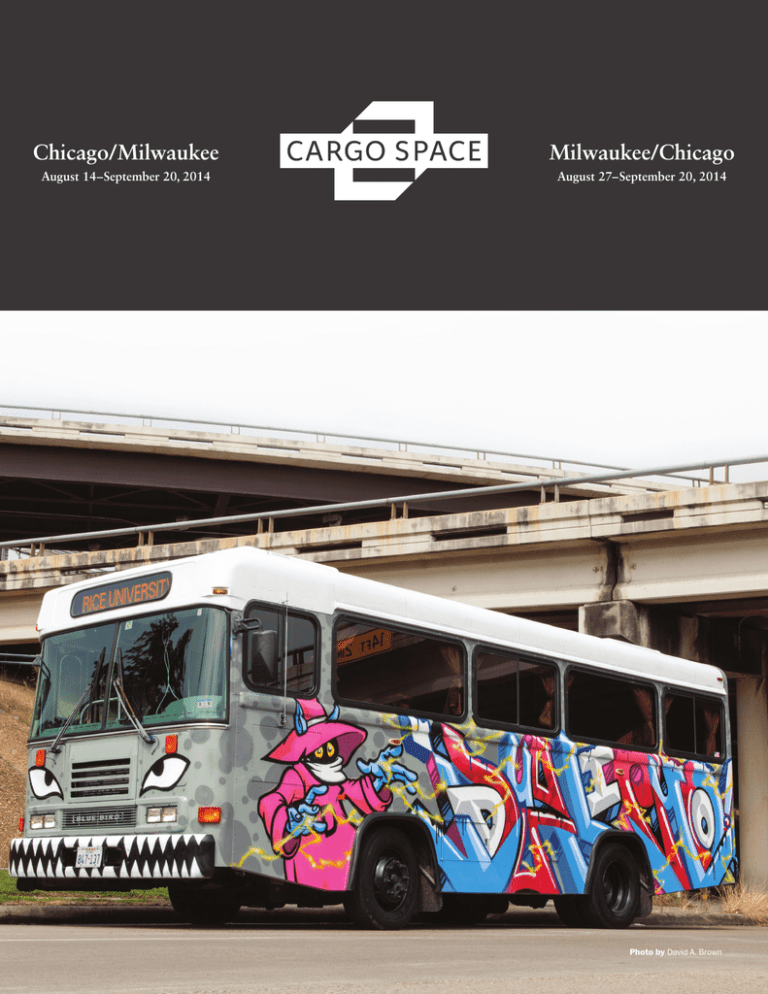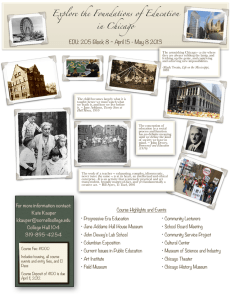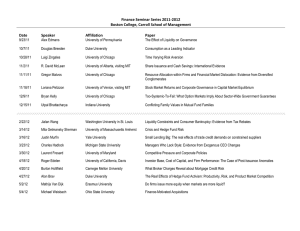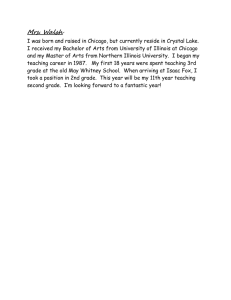Chicago/Milwaukee Milwaukee/Chicago August 14–September 20, 2014 August 27–September 20, 2014
advertisement

Chicago/Milwaukee Milwaukee/Chicago August 14–September 20, 2014 August 27–September 20, 2014 Photo by David A. Brown Journeys are the midwives of thought. Few places are more conducive to internal conversations than a moving plane, ship or train. There is an almost quaint correlation between what is in front of our eyes and the thoughts we are able to have in our heads: large thoughts at times requiring large views, new thoughts new places. Introspective reflections which are liable to stall are helped along by the flow of the landscape. The mind may be reluctant to think properly when thinking is all it is supposed to do. Art of Travel, Alain de Botton The standard “gallery exhibition” is a theoretical proposition made physical. A notion, experience, or affect made concrete and enshrined in a space through objects and images. We are familiar with its basic objective, the creation of a profound or poetic experience, ideally one that makes something unfathomable, real. The “artist residency,” by contrast, is fluid and liminal. It exists to separate a maker from their typical existence and then embed them in another. It is an opportunity to force oneself from the grind of quotidian concerns and to plant oneself in a new and potentially fertile field, even if it is only for a moment. Its aim is to create the conditions for production and to generate new possibilities for the individual artist. Started in 2011, Christopher Sperandio and Simon Grennan’s Cargo Space is the first fully mobile, self-contained art residency and it takes place in a converted diesel bus. At any one time it sleeps a possible six artists—if four of them pair off and figure out who gets to be the inner spoon. It is the kind of residency that is about personal transformation and tourism. An artist hops on this magic school bus—complete with an occasionally surly, but mostly Disney-esque tour guide (often Christopher Sperandio himself)—and has the kind of experience that can change their life. Like Harry Potter catching the night bus, they meet strange new people and travel, for a time, with their brothers and sisters of the art road. Although, it is fun to imagine Grennan and Sperandio (one clutching a dogeared copy of On the Road, while the other holds fast to a beautifully maintained first edition of Zen and the Art of Motorcycle Maintenance) as sculptors merely crafting a bus, just setting a stage for an infinite number of possible outcomes amongst, an as of yet, unknown cast, but the project accesses something deeper. Cargo Space begs us to consider the form of residency. What is a residency? How does it play a role in the production of art and in the production of artists themselves? If Cargo Space is itself an artwork and a residency, where is the “art” experience produced? And for whom does it occur? What do we as viewers witness? What do we see? Or is it about the experience of the artists on their residency? Can the system produce an exhibition? Who can claim authorship of what we see? How on earth can it be presented as an exhibition? Cargo Space is a kind of whirling dervish, a carnival-esque exhibition in which we have asked 12 artists and artist teams from Chicago, Houston, and Milwaukee to accompany Cargo Space through a journey that will begin with a weekend at the Poor Farm Experiment in Wisconsin and roll on towards these concurrent exhibitions in Chicago and Milwaukee. During our time in Wisconsin, the artists will conceive and develop what their residency experiences should be and how those experiences will translate into the exhibitions and events. So, as of this writing I can tell you very little about what these twin exhibitions looks like. I can only tell you that by their nature they will strip back some of the polish that we glaze on to exhibitions and that each day the exhibitions will physically change as the artists develop their vision for the space and their residency. Together we are creating an exhibition experience that is open to sharing the development process, connecting a viewer directly to the artists and curators, and one that is a tad bit messy. Duncan MacKenzie Chicago/Milwaukee Judith Brotman is an artist and educator Heather Mekkelson lives and works in Chicago. from Chicago. Her work has included mixed media installations and theatrical immersive environments that occupy a space between sculpture and drawing. Recent work also includes language/text based conceptual projects that are meditations on the possibility of transformation. Brotman has exhibited extensively in Chicago & throughout the US in venues including threewalls, Chicago Cultural Center, Gallery 400, Illinois State Museum, the DeVos Art Museum, Hampshire College, Smart Museum of Art, The Society of Arts & Crafts, Boston, and The Museum of Fine Arts, Boston. Her work has been exhibited in solo and two person shows at 65GRAND, Roots & Culture, medicine cabinet, Old Gold, threewalls, and STANDARD which are all located in Chicago. She has also been included in group shows at The Museum of Contemporary Photography in Chicago, The Figge Art Museum in Davenport, IA, The Poor Farm in Manawa, WI, Raid Projects in Los Angeles, and Vox Populi Philadelphia. Mekkelson’s work has been written about in Art Journal, Broadsheet, Time Out Chicago, New City, Chicago Tribune, and Artforum.com among others. Alex Chitty is an artist who stands at about 5’6 and is of average weight and build. Born = Miami, 1979 Lives = Chicago (mostly) BFA = Smith College MFA = School of the Art Institute of Chicago Work = Educator at Museum of Contemporary Art & School of the Art Institute of Chicago See More = alexchitty.com Erik L. Peterson is a pro-bono public artist, sculptor, and curator living in Chicago. He is best known for his large-scale urban interventions (Face Value and Inner State) and signature edible ice cream sculptures (CreamCycle and Soft Palate). Public performances employing sculptural elements like Two Tow’n and Square Dance, are camouflaged urban spectacles, while the annual Southwest Wisconsin Make Your Own Softball League game gathers artists who build their own bats and balls in order to play. Additionally, Peterson is a founder of Hyde Park Kunstverein, a community museum and solo project space in Chicago. John Sparagana received his MFA from Stanford University in 1987. He has presented solo exhibitions of his work in New York, San Francisco, Chicago, Houston and internationally. He has been the recipient of numerous awards and fellowships. Among these are awards from the National Endowment for the Arts, the Cultural Arts Council of Houston and Cité International Des Arts, Paris (through Stanford University). Wacom, TX is a comedy channel created by Jay Meyers and Chris Kerr. The duo creates and stars in episodes about art, comedy and life. Jay Meyers received a BA in flim and video from Columbia College Chicago in 2011. Since graduation, he has created two human beings and scores of feature length, shorts, documentaries, music videos, animations, experimental work and one wedding video. Chris Kerr received a BFA in Fine Art from The School of the Art Institute of Chicago in 1999. Since graduation, he has shown his paintings, drawings, prints, and sculptures nationally and internationally. 5 1 3 2 4 6 Milwaukee/Chicago Organizers Sara Daleiden directs MKE<->LAX to investigate cultural exchange between two American regions through residencies and public programs focused on the arts. With bases in Milwaukee and Los Angeles, MKE<->LAX offers support for empathetic, structural development of independent, organizational and community identity embracing various scales of experimentation and production. The initiative encourages active interpretation and embodied exploration of local places valuing public space, civic participation, economic sustainability, pedestrian awareness and celebration of difference. In Milwaukee, Daleiden is currently working with America’s Black Holocaust Museum, ‘Creational Trails, Friends of Blue Dress Park and the Milwaukee Artist Resource Network. Shana McCaw and Brent Budsberg have Duncan MacKenzie is an Artist, Pundit, Educator collaborated since 2001 in a wide variety of media. Their work often incorporates scale models to explore notions of scale, deception, and suspension of disbelief. McCaw and Budsberg are founding members of the WhiteBoxPainters, a performance art group specializing in large-scale, temporary public projects. Recent exhibitions include solo shows at Spaces Gallery in Cleveland and the James Watrous Gallery in Madison. The duo have had residencies with MKE<->LAX in LA and the Center for Land Use Interpretation’s outpost in Wendover, UT, and received a Mary L. Nohl Fellowship for Individual Artists from the Greater Milwaukee Foundation in 2008. and a Founding Member/Producer of Bad at Sports. (badatsports.com) His works have appeared in galleries all over the world including Canada, Australia, The United States of America, New Zealand, Estonia and England. Bad at Sports, a project he began with Richard Holland in 2005, is one of the USA largest arts resources and continues to grow every week, currently sharing an archive of 350 hours worth of audio documenting the art history of Chicago, New York City and San Francisco, and over 2000 posts by the best art writers in Chicago. His work has been discussed in Flash Art, Art Forum, the New York Times, Time Out, and many other venues. He currently enjoys a posting as an Assistant Professor in Art + Design at Columbia College Chicago. Paul Druecke lives in Milwaukee, WI. For his projects, Druecke has undertaken endeavors as diverse as initiating a Board of Directors to memorializing the at of memorialization. His residencies and fellowships have resulted in permanent, public installations of bronze plaques that commemorate their own legitimacy. Druecke has worked with the Kölnischer Kunstverein in Cologne, The Suburban in Chicago, and the Many Mini Residency in Berlin, among other national and international venues. His work was included in the 2014 Whitney Biennial and he is an invited resident at the 2014 Zentrum für Kunst und Urbanistik in Berlin. Ashley Morgan received her MFA in sculpture from the University of WisconsinMilwaukee and her BFA in visual arts at Arkansas State University. She has created site-specific installations and been a part of numerous group exhibitions both nationally and internationally. Morgan was selected as a fellow for the Greater Milwaukee Foundation Mary L. Nohl Fellowship and awarded a Sonnabend Fellowship from the Museum of Jurassic Technology in Los Angeles. She lives and works in Milwaukee, where she is an instructor at the Milwaukee Institute of Art & Design. Simon Grennan and Christopher Sperandio met at the University of Illinois, Chicago in 1988 and have worked together exclusively as a team since 1990. Grennan works from North Wales, and Sperandio works from Houston, Texas. Two things remain constant in their practice: they always work together and their work invariably involves the authorial or editorial participation of other people—other members of the public. Their work often utilizes media that are culturally compromised: chocolate, comic books and television, appearing at social sites of consumption in the home and store and on the street. They are often seen as part of a critical history of artists whose work is focused on social narrative and social exchange. Over the last twenty years, this history of practice has been described as ‘interventionist’, ‘New Genre’, and ‘Relational’. In 2010, Bucharest Biennial curator Felix Vogel chose the term ‘handlung’ (‘acting together’) to describe the social turn in this approach to practice. thecargospace.com. 1 Judith Brotman, The Reading Project, 2014, Photo credit: Kurt Peterson 2 Alex Chitty, Of Wood and Other Bodies Petrified, 2013, Powder coated steel, green and clear glass, black class cups, stoneware, ash baseball bat, porcelain, shoelace, jewelers pincers, stainless steel, Photo by Joseph Rynkiewicz 3 Heather Mekkelson, Blue Crater No. 5, 2013–2014, 24” x 24” x 7”, Blue marking chalk, glass, plastic painter’s points 4 Erik L. Peterson, Plop, 2014, Neon 5 John Sparagana, Crowds & Powder: Kennedy Brothers, 2014 6 Wacom, TX 7 Sara Daleiden, MKE<->LAX Suitcase, © MKE<->LAX, 2012, Photo by Harvey Opgenorth 8 Paul Druecke, Poor Farm, 2012, Cast aluminum, wood, cement, fastening hardware 9 Shana McCaw and Brent Budsberg, Foundation, 2011, Charcoal, Earth, 300” x 300”, Photo by the artists. Location: Lynden Sculpture Garden, River Hills, WI 10 Ashley Morgan, Complete, 2013 9 7 8 10 INSTITUTE OF VISUAL ARTS a+D I NOVA AVERILL AND BERNARD LEVITON GALLERY HOURS 2155 North Prospect Avenue GALLERY HOURS A+D GALLERY TUESDAY – SATURDAY Milwaukee, Wisconsin 53202 TUESDAY – Saturday 619 SOUTH WABASH AVENUE 12PM – 5PM (414) 229-5070 12pm – 5PM arts.uwm.edu/inova CHICAGO, ILLINOIS 60605 312 369 8687 THURSDAY COLUM.EDU/ADGALLERY 12PM – 7PM Admission to INOVA is free THURSDAY 12pM – 8PM Started in 2011, Cargo Space is a residency housed in a converted diesel transit bus. Sleeping up to six, this mobile living unit provides direction connections between practitioners who are geographically separated. Chicago/Milwaukee Milwaukee/Chicago August 14–September 20, 2014 Reception: September 19, 5–8PM August 27–September 20, 2014 Reception: August 27, 6–8PM Participating Chicago Artists Judith Brotman, Alex Chitty, Heather Mekkelson, Erik L. Peterson, John Sparagana, and Wacom, TX. Participating Milwaukee Artists Sara Daleiden, Paul Druecke, Ashley Morgan, and Shana McCaw/ Brent Budsberg. Cargo Space (thecargospace.com) is a project by Simon Grennan and Christopher Sperandio Co-organized by Duncan MacKenzie Cover Photo by David A. Brown INSTITUTE OF VISUAL ARTS




